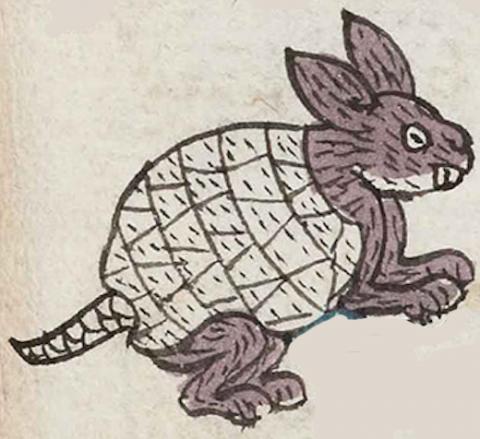ayotochtli (Mdz51r)
This compound glyph for the armadillo (ayotochtli) has been carved from the even more compound place name, Ayotochco. The animal pictured here has a black and white "armored" back and tail (segmented and textured), suggestive of the armadillo. The front and legs of this visually hybrid animal is a rabbit (tochtli), colored purplish-gray and white. The rabbit's eye, teeth, and chin are white. The animal is in profile, facing to the viewer's right.
Stephanie Wood
The animal's head is rabbit-like, emphasizing the phonetic element (tochtli) that hides within ayotochtli
In reality, armadillos have a pointy snout and an armored tail. The feet are more claw-like than the rabbits. These differences reinforce the presence of rabbit elements as an intentional phonetic indicator for the "toch" part of ayotochtli. For further information on the armadillo, see Mexicolore's study of it.
Stephanie Wood
Stephanie Wood
c. 1541, or by 1553 at the latest
Stephanie Wood
armadillos, rabbits, conejos
This example of a yin-yang pair of armadillos comes from a wooden door covered with animals and made by students as a decoration for the Escuela Libre de Escultura y Talla in the Ex-convento de la Merced, Mexico City, in 1927. Note the rabbit-like ears and the armored back and tail. Museo Nacional del Arte, Mexico City. Photo by S. Wood, 4 May 2025.

ayotoch(tli), armadillo, https://nahuatl.wired-humanities.org/content/ayotochtli
toch(tli), rabbit, https://nahuatl.wired-humanities.org/content/tochtli
armadillo.
Stephanie Wood
Codex Mendoza, folio 51 recto, https://codicemendoza.inah.gob.mx/inicio.php?lang=english
The Bodleian Libraries, University of Oxford, hold the original manuscript, the MS. Arch. Selden. A. 1. This image is published here under the UK Creative Commons, “Attribution-NonCommercial-ShareAlike 3.0 License” (CC-BY-NC-SA 3.0).


